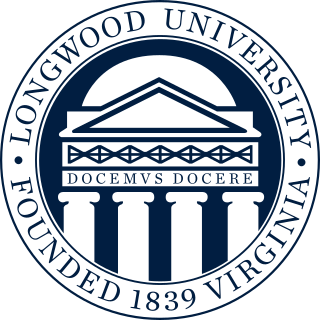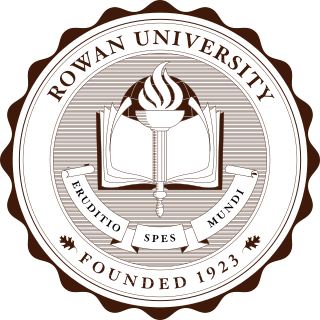
Central Washington University (CWU) is a public university in Ellensburg, Washington, United States.

The University of South Dakota (USD) is a public research university in Vermillion, South Dakota. Established by the Dakota Territory legislature in 1862, 27 years before the establishment of the state of South Dakota, USD is the flagship university for the state of South Dakota and the state's oldest public university. It occupies a 274 acres (1.11 km2) campus located in southeastern South Dakota, approximately 63 miles (101 km) southwest of Sioux Falls, 39 miles (63 km) northwest of Sioux City, Iowa, and north of the Missouri River.
New Jersey City University (NJCU) is a public university in Jersey City, New Jersey. Originally chartered in 1927, NJCU consists of the School of Business, College of Arts and Sciences, College of Education, and College of Professional Studies and is part of New Jersey's public system of higher education. In 2022, it announced that it was severely reducing its academic offerings due to a budgetary crisis. In 2024, the school was considered financially stable though still underfunded.

Old Dominion University (ODU) is a public research university in Norfolk, Virginia. Established in 1930 as the Norfolk Division of the College of William and Mary, an extension school of the College of William & Mary for people with fewer financial assets, members of the military, and non-traditional students in Norfolk-Virginia Beach area of the Hampton Roads region. The university has since expanded into a residential college for traditional students and is one of the largest universities in Virginia with an enrollment of 23,494 students for the 2023 academic year. The university also enrolls over 600 international students from 99 countries. Its main campus covers 250 acres (1.0 km2) straddling the city neighborhoods of Larchmont, Highland Park, and Lambert's Point, approximately five miles (8.0 km) north of Downtown Norfolk along the Elizabeth River.

Longwood University is a public university in Farmville, Virginia. Founded in 1839 as Farmville Female Seminary and colloquially known as Longwood or Longwood College, it is the third-oldest public university in Virginia and one of the hundred oldest institutions of higher education in the United States. Previously a female seminary, normal school, and college, Longwood became coeducational in 1976 and gained university status on July 1, 2002.

Bradley University is a private university in Peoria, Illinois, United States. Founded in 1897, Bradley University enrolls 5,400 students who are pursuing degrees in more than 100 undergraduate programs and more than 30 graduate programs in five colleges. The university is accredited by the Higher Learning Commission and 22 specialized and professional accreditors.

The University of North Dakota (UND) is a public research university in Grand Forks, North Dakota. It was established by the Dakota Territorial Assembly in 1883, six years before the establishment of the state of North Dakota.

Delaware State University is a privately governed, state-assisted historically black land-grant research university in Dover, Delaware. DSU also has two satellite campuses: one in Wilmington and one in Georgetown. The university encompasses four colleges and a diverse population of undergraduate and advanced-degree students. Delaware State University is classified among "R2: Doctoral Universities – High research activity".

Valley City State University (VCSU) is a public university in Valley City, North Dakota. It is part of the North Dakota University System. Founded in 1890 as Valley City State Normal School, a two-year teachers' college, it was authorized to confer bachelor's degrees in 1921 and changed its name to Valley City State Teachers College. With an expansion in programs outside teacher education after World War II, it became Valley City State College in 1963. In 1986, it was renamed State University of North Dakota-Valley City and a year later received its current name.

Rowan University is a public research university in Glassboro, New Jersey, with a medical campus in Stratford and medical and academic campuses in Camden. Founded in 1923 as Glassboro Normal School on a 25-acre (10 ha) site donated by 107 residents, the school was formerly known as Glassboro State College from 1958 until 1992 and Rowan College of New Jersey from 1992 to 1997.
The University of Mary is a private, Benedictine university near Bismarck, North Dakota that has 3,852 students. It was established in 1959 as Mary College.

Pacific University is a private university in Forest Grove, Oregon. Founded in 1849 as the Tualatin Academy, the original Forest Grove campus is 23 miles (37 km) west of Portland. The university maintains three other campuses in Eugene, Hillsboro, and Woodburn, and has an enrollment of more than 3,000 students.

Nova Southeastern University (NSU) is a private research university with its main campus in Fort Lauderdale-Davie, Florida, United States, in the Miami metropolitan area. The university consists of 14 total colleges, offering over 150 programs of study. The university offers professional degrees in the social sciences, law, business, osteopathic medicine (DO), allopathic medicine (MD), health sciences, pharmacy, dentistry, optometry, physical therapy, education, occupational therapy, and nursing. As of 2019, 20,576 students were enrolled at Nova Southeastern University, with more than 210,000 alumni. With a main campus located on 314 acres in Davie, Florida, NSU operates additional campuses in Dania Beach and Tampa-Clearwater, and other locations throughout the state of Florida, as well as in San Juan, Puerto Rico and Denver, Colorado.

Northern State University (NSU) is a public university in Aberdeen, South Dakota, United States. NSU is governed by the South Dakota Board of Regents and offers 45 bachelor's degrees, 53 minors, six associate degrees, 16 pre-professional programs, 23 certificates and 10 graduate degrees.

Salem State University is a public university in Salem, Massachusetts. Established in 1854, it is the oldest and largest institute of higher education on the North Shore and is part of the state university system in Massachusetts.

Waynesburg University is a private Christian university in Waynesburg, Pennsylvania. It was established in 1850 and offers undergraduate and graduate programs in more than 70 academic concentrations. The university enrolls around 1,400 students, including approximately 1,100 undergraduates.

Tom Jackson Jr. is an American academic who served as president of California Polytechnic University Humboldt from fall 2019 to August 2024. He is best known for overseeing the university's transition to a polytechnic.
The Black Hills Brawl is an annual football game between Black Hills State University and South Dakota School of Mines and Technology. Also known as The Battle for the Homestake Trophy or rarely called the West River Rivalry, the winner of the game receives the Homestake Trophy. The current venues the game is played in are Lyle Hare Stadium since 1960 and O'Harra Stadium since 1938. First played in 1895 and played 138 times, the Black Hills Brawl is the most played in NCAA Division II and tied for the oldest rivalry in DII ; it is the 4th most played rivalry nationwide in any division.
Paul Sather is an American college basketball coach, currently head men's basketball coach at the University of North Dakota.
Lionel Raphael Bordeaux was a Sicangu Lakota educator, advocate, and president of Sinte Gleska University (SGU) from 1973 until his death in 2022. At the time of his death, he was the longest-serving college or university president in the United States. During his time as university president, SGU became the first tribal university in the United States, and became the first tribal higher learning institution to achieve both bachelor's and master's degree accreditation.















